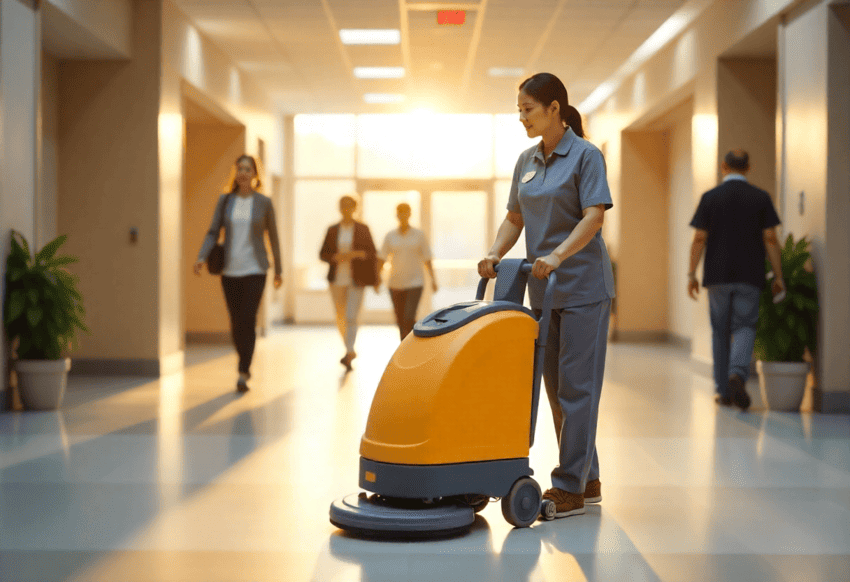In any hospital, especially during peak hours, you see that hygiene isn’t a separate task. It’s a system where people, processes, and tools move in step. The right cleaning equipment in hospital settings from Jacleen helps cut cross-contamination, speeds up room turnovers, and keeps both staff and patients safe. This guide looks at daily operations and highlights the equipment that makes a real difference.
Why do hospitals need different gear?
With busy corridors, sensitive spaces, and strict hygiene standards, hospitals can’t rely on ordinary tools. They need equipment that’s durable, resists chemicals, sanitizes easily, and is purpose-built for medical settings. Pedal bins must close firmly every time, trolleys need to stay stable when fully loaded, mop frames should hold up to constant disinfection, and machines have to clean fast without leaving floors damp for long. When you standardize across wards—using the same bin sizes, the same mop heads, and the same cart layouts—training gets simpler, and stock control stops being a guessing game.
1. Waste management: design out the risk
Hospitals generate multiple waste streams, so a bin isn’t just a bin. In clinical and isolation areas, pedal-operated lids help keep hands off surfaces, and tight-closing tops reduce odor and exposure. Color cues and prominent labels prevent mix-ups when staff are moving at speed. Stainless-steel bodies work well where frequent wipe-downs with strong chemicals are required; high-grade plastic suits general areas and larger wheelie bins used for central collection.
The most important decision is placement. Put the right bin at the point of care, not down the corridor. When nurses and cleaners don’t have to travel to dispose of waste, you remove friction from the workflow and cut risk at the same time.
2. Floors first: mops, buckets, and microfiber that actually hold up
Floors carry everything—shoes, trolleys, stretchers, drips—so the basics matter. Microfiber systems pick up soil efficiently and release it during rinsing, while Kentucky mop sets still shine for fast coverage in long corridors and general wards. Whichever you choose, make the process easy to repeat: one bucket for clean solution, one for rinse, and fresh solution per room or zone. A solid wringer takes the strain off staff and squeezes more water from the mop head, which means floors dry quicker. Pair it with a floor squeegee to handle spills and clear excess water after washing.
This simple pairing—microfiber or Kentucky with proper wringing and quick squeegee work—often does more for real-world safety than fancy chemicals alone.

3. Carts and trolleys: bring the “room on wheels.”
Well-planned carts cut distance and time, which is why they are one of the highest-impact investments you can make. A good housekeeping trolley keeps chemicals upright and sealed, separates clean and soiled linens, and gives every tool a fixed parking spot so staff aren’t hunting for items mid-round. Closed compartments keep supplies clean in busy areas. Smaller carts fit better in narrow ICU corridors, while larger frames work well in general wards and public spaces.
If your team transports instruments, PPE, and linens together, consider dedicated carts per task rather than a “one cart does everything” approach; it’s easier to keep cross-contamination under control when tasks are physically separated.
4. Machines that make deep cleaning faster
Mopping handles the everyday stuff. For bigger cleans, you need machines that actually pull up dirt and save time. Small scrubbers or polishers are good for lobbies and corridors—they clean better than a mop and dry faster. In carpeted waiting rooms, use extractors to pull out water so floors dry quickly. A wet-and-dry vacuum is useful for spills and after repair work. Use smaller machines in patient rooms and walk-behind models for long corridors. If storage is tight, one modular machine with kits is better than keeping many single-use units.
5. Windows, glass, and the daily touchpoint routine
Hospitals have plenty of glass—observation windows, partitions, nurse station screens—and they show smears immediately. A simple window set with telescopic poles, squeegees, and microfiber sleeves keeps visibility high without heavy chemicals. For touchpoints like bed rails, call buttons, and door handles, the equipment story is straightforward: labelled spray bottles, quality microfiber cloths, and a disciplined cloth-rotation routine. Color coding helps staff know which cloth belongs to which zone; the fewer decisions they make at the sink, the less likely mistakes will happen during a busy shift.
Choosing a supplier that won’t slow you down
Beyond price, look for depth of range and continuity of supply. Cleaning equipment in hospital environments lives a hard life; you want replacement heads, liners, pads, and small parts to remain available over time. A supplier who carries industrial cleaning machines, day-to-day tools, dedicated cleaning trolleys and carts, and multiple waste-bin options lets you spec once and scale across wards without inventing a new setup for every floor. It also simplifies training and keeps your storerooms calmer—fewer shapes, fewer surprises.

Final word
Great outcomes in healthcare cleaning come from simple, repeatable setups supported by the right tools. Put waste segregation at the point of care, choose mop systems staff can use correctly every time, bring the “room on wheels” with a well-planned trolley, and schedule machine-based deep cleans that fit the clinical day. When your equipment choices support the way clinicians actually work, compliance rises, rooms turn over faster, and risks go down. If you’re building a procurement list, start small but standardized, then add machines and specialist tools as your routines settle. That’s how cleaning equipment in hospital environments earns its keep—not by being fancy, but by making the right action the easy one, every single time.
Looking to upgrade your setup? Jacleen provides reliable cleaning equipment that helps you keep operations smooth and spaces hygienic.
